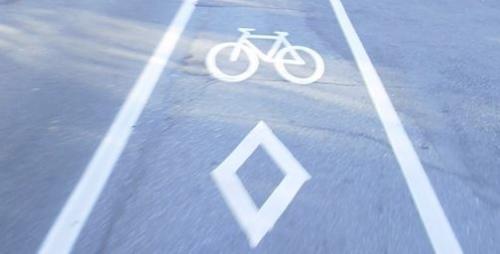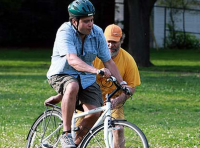ghet-to[get-oh]
–noun, plural -tos, -toes.
1.a section...inhabited predominantly by members of an ethnic or other minority group, often as a result of social or economic restrictions, pressures, or hardships...
sanc-tu-ar-y[sangk-choo-er-ee]
–noun, plural -ar•ies.
...7.any place of refuge; asylum.
(Courtesy of dictionary.com)
Typically the popular imagination assigns these places opposite ends of the spectrum. Simply put, sanctuary is for the worthy few; a ghetto, the base underclass. You're expected to want into sanctuary, and expected to want the hell out of the ghetto. But things are rarely that simple.
There can be comfort and security among your own kind --no matter how low they may be -- and in 'knowing your place' though it be at the cost of greater possibilities and inclusiveness. The arrangement can also be expedient to the wider world: marginalizing problems is easier than confronting and resolving the dilemmas at their heart. Ask any politician. Just don't expect an honest answer.
Stripped of connotations ghettos and sanctuaries can appear as one and the same. And what would that look like? How about something like this?

Ironic that bike lanes, the most conspicuous mark (of success?) in Toronto cyclists' campaign for more inclusive streets, are by definition exclusive.
By some cyclists they're considered a policy of inferiority, segregating pedallers to the sidelines instead of urging them to the center where they can assume their rightful place among equals; by cagers, a capitulation to special interests, mollifying autophobes and reserving precious road space for a privileged few; and by wonks a program in social engineering, coercing the reluctant into favourable habits. Not even Da Vinci could accomplish so much with paint.
Vehicular cyclists contend that segregating bicycles only absolves drivers of the responsibility of truly sharing the road: it keeps pedallers out of the way so they can continue happily driving amok without extending due regard to other road users. Translation: drivers are spared the obligation of safe decelerations by braking and can continue stopping by the preferred method, collision.
Bike lane advocates counter that lanes boost cycling rates, that they declare emphatically that bikes belong on the road. Er, make that on the side of the road. It's a case of if you can't the beat the cars, then join 'em, that is, by not joining them. Everybody in their own place, two solitudes coming together to their mutual exclusion. Something like marriage perhaps.
So we have our sanctuary alongside the sewer grates and gutters. And though cagers don't seem to want bike lanes anywhere, they certainly want cyclists there, that is to say, nowhere. That's OK: half the cyclists don't think we should be there either if only we would all share the road which is ostensibly why the bike lanes were installed in the first place. It's all starting to make sense.
But no one said that after we fought to get them, we'd have to fight to defend them. Add a few light bulbs worth of inorganically derived wattage and the works short circuits. Lane Wars!
The eRumble-- batteries definitely included -- glides along at a blazing 32 k/h, a muddle of functional and simulated pedals, wonky knees and dayglow spandex; it's all fun and games until we have a serious casualty. Namely, the battery dies. Then the eHeretics must call CAA for a boost and the Orthodox pedal pushers who wouldn't tolerate them riding in bike lanes must tolerate them stalled there. And everybody goes nowhere just as fast in an environmentally friendly circle jerk of acrimony.
What's next? Who knows? But depend on it, there will be something next.
[img_assist|nid=3150|title=Apres eCycles?|desc=|link=node|align=right|width=123|height=150]
I suppose it's to be expected: a corollary of separate but not really equal facilities for cyclists is the same consideration for every other type of road user. So hate eBikes if you will, but love eBikers and give 'em the lane. Any lane but yours that is. It's only fair, right? Any pedaller that's skidded through the emissions of Toronto's Finest Mounted Units, steaming squarely in middle of the bike lane, can attest to the merits of vehicular apartheid.
Or is an egalitarian wheelocracy the way to go? Ever moseyed down a bike lane on a side street and wondered what's the point of the paint? Then again, ever white knuckled it over a 401 overpass grasping all too well the exact point of a personally reserved, officially sanctioned two meters of roadside ghetto (if there only was one)? Therein lies the ambivalence; not in the concept but in the (mis)application.
There really must be a more nuanced, discriminating approach to the applicability of segregated lanes: their installation shouldn't automatically be considered a boon for cyclists. Non bicycle specific measures such as traffic calming obstacles, lower speed limits, and parking strategies, by taming the motorized beast, can be just as effective at improving bikeability without limiting the benefits and supporters -- and ill will directed! -- to cyclists exclusively.
Happily, there's a symbiosis between bikeability and more hospitable neighbourhoods and urban spaces -- and that's the real name of the game, improved bikeability and liveability, not bike lanes per se, they're just one among many tools available to planners.
That may or may not mean more spilt paint; it definitely means a more critical assessment of motorists' prerogatives. Consequently, expect to be labelled a War Criminal and pelted with copies of the Geneva Convention by all that collateral damage in bombed out Beemers and Hummers. War is hell after all.
Too bad cycling Toronto's streets can be as well. As long as it is (e)cyclists will continue to find themselves seeking the comfort of, or grudgingly relegated to, that narrow strip behind the white line. Whatever that space may be to you.


